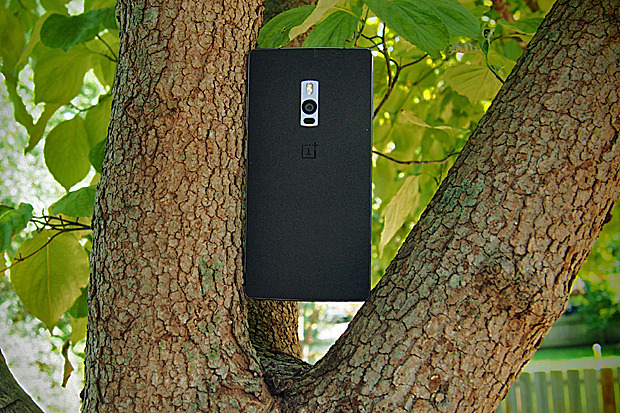
I've been thinking a lot about the OnePlus 2 lately.Â
And you know what? More than anything, I've been thinking about how strange it is that this phone is such a big deal.
I should qualify that: It's a big deal in the relatively little pond of Android enthusiasts in which most of us swim. The vast majority of "normal" people have never heard of it -- and that's an important fact to keep in mind as we dive deeper into this conversation.
First, a quick primer: OnePlus, if you happen to be among those who aren't familiar with it, is a small China-based startup that made a lot of noise with its inaugural OnePlus One phone release last year. The device offered a then-crazy-seeming kind of value: respectable and almost flagship-like specs for a mere $299, unlocked and off-contract. At the time, that sort of pricing was unheard of, especially here in America. Combined with its also-unusual use of the enthusiast-approved Cyanogen OS version of Android, the OnePlus One grabbed plenty of attention from those who closely follow the platform.
The OnePlus 2
The company's new OnePlus 2 tries to build on that momentum -- though this time without Cyanogen, and with a somewhat higher price. The OnePlus 2 uses a new custom version of Android called OxygenOS and starts at $389. (A lower-storage model is also expected to sell for $329 at some point, but it's not yet clear when it'll become available.)
No question, that's still a solid price for an off-contract phone of this caliber. There's just one problem: The rest of the smartphone ecosystem has slowly but surely started to catch up. Oh, and OnePlus makes it damn-near impossible to actually buy its device.
The company sells its smartphones on an "invite-only" basis (yes, really). To put it in layman's terms, you can't buy the thing unless you're willing to jump through a lot of hoops and practically beg the company to let you give them your money. (Alternatively, you can find someone who already has an invite and convince them to pass an invite along to you instead.)
The OnePlus invite system, as explained on oneplus.net
OnePlus has made this system work through what can only be described as aggressive guerilla marketing (and that's guerilla, not gorilla -- though the latter would certainly be interesting, too). It does things like make sensational and sometimes over-the-top claims about how its phones "never compromise" and are "2016 flagship killers."
Following what I'll reluctantly call the "Kanye model," the statements are often so grandiose that they're practically guaranteed to be repeated (even if sometimes mockingly) by bloggers and tweeters. And beyond that, instead of simply announcing its devices, as most manufacturers do, OnePlus releases one tiny detail at a time to tech blogs -- thereby drawing out the process considerably and maximizing the amount of coverage it receives (even if annoying some readers in the process).
So what's actually behind all that hype? I've been using the OnePlus 2 for a little while now, and if you don't mind the rough sandpaper-textured back and occasional software glitchiness, it's a fine enough phone. Solid and capable? Absolutely. Good value for the money? Sure. There's nothing really exceptional about it beyond its price, though -- and that's where things start to get tricky.
For all practical purposes, would this phone even exist if it weren't for the guerilla marketing?
Price has been the driving force that's convinced savvy shoppers to put up with OnePlus's pain-in-the-patootie purchasing system and the other asterisks that come with getting a smartphone from a little-known, limited-resource company. But with Motorola getting ready to sell its flagship-caliber 2015 Moto X for $400 unlocked, that advantage is suddenly looking a lot less significant. If the Moto X is widely available to purchase with ease -- and if it delivers on having impressive stamina and camera quality along with the excellent build quality, top-notch user experience, and other assets we've come to expect from Motorola devices -- the OnePlus's "X-factor" might be, well, out-X'd.
And yet, a fair number of people are still eager to line up for their chance to buy the OnePlus 2.Â
When you stop and think about it, that's pretty fascinating -- that this company's products continue to draw so much attention when they're so difficult to buy and their only marketing relies upon blogs (and then from there, social media users) to spread the word. To flip that around, it makes you wonder:Â For all practical purposes, would the OnePlus 2 even exist if it weren't for its manufacturer's guerilla marketing tactics and the responses they inspire?
Now, obviously, the device could still exist in a literal sense. What I'm saying is, would anyone really care?
It's an academic point, to be sure, but an interesting one to consider. After all, we're seeing more and more affordable Android phones this year, and none of them gets the kind of electricity-charged buzz that's surrounded these first two OnePlus releases. Were it not for the unconventional marketing methods -- and the emotional connections they've helped establish -- one might contend that the OnePlus 2 would be just another niche-level device that gets a wave of low-key coverage and then dukes it out with other low-cost phones in the small-scale arena of off-brand sales.
But OnePlus, love it or hate it, has done something different. The company has managed to build up an identity and a group of passionate followers who buy into its brand -- and continue to support it, even amidst heated competition at the same price range.
What's most impressive about the OnePlus 2 isn't the phone itself; it's the fact that its manufacturer has managed to make people care. And for a little-known company that can't create enough of its devices to sell them in any open manner, that's a pretty remarkable feat to achieve.
RELATED TOPICS View Comments